AUGUST KEY FIGURES
 |  | Aug '06 | Jul '06 to Aug '06 | Aug '05 to Aug '06 |  |
 |  | '000 | % change | % change |  |
|  |
| Short-term visitor arrivals |  |  |  |  |
 | Trend | 445.2 | -0.6 | -2.9 |  |
 | Seasonally adjusted | 444.4 | -0.5 | . . |  |
 | Original | 413.6 | . . | . . |  |
| Short-term resident departures |  |  |  |  |
 | Trend(a) | 418.6 | 0.7 | 4.1 |  |
 | Seasonally adjusted | 412.6 | 0.6 | . . |  |
 | Original | 395.8 | . . | . . |  |
|  |
| . . not applicable |
| (a) Break in trend series from October 2005. |
Visitor arrivals, Short-term
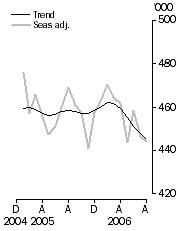
| Resident departures, Short-term
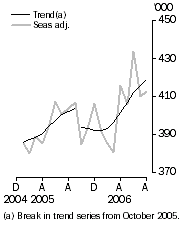
|
AUGUST KEY POINTS
TREND ESTIMATES
- Trend estimates for short-term visitor arrivals to Australia during August 2006 (445,200 movements) decreased by 0.6% compared with July 2006. This followed monthly decreases of 0.9% for June 2006 and 0.7% for July 2006.
- Currently, short-term visitor arrivals are 3.7% lower than when the series last peaked in February 2006 (462,100 movements) and 2.9% lower than in August 2005.
- During August 2006, short-term resident departures (418,600 movements) increased by 0.7% compared with July 2006. This followed monthly increases of 1.2% for June 2006 and 0.9% for July 2006.
- The short-term resident departures trend series is now experiencing consistent growth, following a period of stability after the trend break in October 2005.
SEASONALLY ADJUSTED ESTIMATES
- Seasonally adjusted estimates for short-term visitor arrivals during August 2006 (444,400 movements) decreased by 0.5% compared with July 2006 and followed a monthly increase of 3.3% for June 2006 and a monthly decrease of 2.5% for July 2006.
- Short-term resident departures for August 2006 (412,600 movements) increased by 0.6% compared with July 2006 and followed a monthly increase of 6.9% for June 2006 and a monthly decrease of 5.4% for July 2006.
ORIGINAL ESTIMATES
- In original movement terms, there were 413,600 short-term visitor arrivals to Australia and 395,800 short-term resident departures from Australia during August 2006.
NOTES
FORTHCOMING ISSUES
| ISSUE | Release Date |
| September 2006 | 6 November 2006 |
| October 2006 | 5 December 2006 |
| November 2006 | 11 January 2007 |
| December 2006 | 6 February 2007 |
| January 2007 | 7 March 2007 |
| February 2007 | 5 April 2007 |
EARLY ESTIMATES
Early estimates of short-term visitor arrivals for September 2006 will be available on the Australian Bureau of Statistics (ABS) web site on 18 October 2006. These estimates can be accessed by going to the ABS web site at <https://www.abs.gov.au>. Select All statistics - Access to all ABS products & statistics, then By Catalogue Number, then 3. Demography, then 34. Migration. Choose Short-term Visitor Arrival Estimates, Australia (cat. no. 3401.0.55.001).
DATA NOTES
This publication contains movement data. Care should be taken when interpreting this movement data as 'people'. See paragraph 5 of the Explanatory Notes for more detail.
The statistics in this publication have been rounded to the nearest 100 for short-term movements and to the nearest 10 for permanent and long-term movements. As a result, sums of the components may not add exactly to totals. Analysis featured in the Key Points and Main Features of this publication is based on unrounded data. Calculations made on rounded data may differ to those published.
CHANGES IN THE ISSUE
Permanent arrivals and country of previous residence - The proportion of permanent arrivals whose country of previous residence is not stated has increased markedly over the last two years. For these movements ABS has previously imputed this data item using country of embarkation information as well as stated responses of other permanent arrivals. Due to the high level of not stated responses currently being observed, records of permanent arrivals whose country of previous residence is not stated will not be imputed for August 2006 data onwards. For all other arrivals, imputation based on country of embarkation will continue.
New seasonally adjusted and trend estimates series - As a result of the annual review of the seasonally adjusted series (advised in the July issue of this publication) ABS is now able to disseminate additional series via the time series spreadsheets and data files associated with this product. Some series have been disseminated with a warning regarding the reliability of the series. For the time series spreadsheets the warning is attached to the individual series while for the time series data files the warning is included with the time series data files advisory notes.
For short-term visitor arrivals the additional seasonally adjusted and trend series are: Russian Federation, Other Oceania and Antarctica, Other North-West Europe, Other Southern and Eastern Europe, Other North Africa and the Middle East, Other South-East Asia, Other North-East Asia, Other Southern and Central Asia, Other Americas and Other Sub-Saharan Africa. Additionally, East Timor is disseminated for the trend series only.
For short-term resident departures the additional seasonally adjusted and trend series are: Argentina, Brazil, Cambodia, Chile, Cook Islands, Mauritius, Mexico, Nepal, Tonga, the United Arab Emirates, Other Oceania and Antarctica, Other North-West Europe, Other Southern and Eastern Europe, Other North Africa and the Middle East, Other South-East Asia, Other Southern and Central Asia, Other Americas and Other Sub-Saharan Africa. Additionally, East Timor, French Polynesia and Other North-East Asia are disseminated for the trend series only.
REVISIONS
Table 6 - The financial year 2005-06 total has been revised to 5,484,100 movements (from 5,484,000 movements) for 'intended length of stay' and 'main reason for journey'.
INQUIRIES
For further information about these and related statistics, contact the National Information and Referral Service on 1300 135 070 or Anne Ward on Canberra (02) 6252 6871.
MAIN FEATURES
SHORT-TERM VISITOR ARRIVALS
In trend terms, short-term visitor arrivals to Australia in August 2006 (445,200 movements) were 0.6% lower than in July 2006 and 2.9% lower than in August 2005. Short-term visitor arrivals are currently 3.7% lower than when the series last peaked in February 2006 (462,100 movements).
The following table presents the top ten source countries (based on original estimates) for short-term visitor arrivals during August 2006. Seasonally adjusted and trend estimates are also presented for these countries, along with the percentage change in trend compared with July 2006 and August 2005.
Short-term Visitor Arrivals, Major Source Countries - August 2006 |
|  |
 | Trend | Seasonally Adjusted | Original | Jul 06 to Aug 06 | Aug 05 to Aug 06 |  |
 | '000 | '000 | '000 | Trend % change | Trend % change |  |
|  |
| New Zealand | 85.8 | 82.2 | 90.9 | -0.9 | -5.6 |  |
| Japan | 50.8 | 52.2 | 61.1 | 0.1 | -10.9 |  |
| United Kingdom | 55.7 | 56.0 | 37.8 | -1.8 | -5.0 |  |
| United States of America | 36.8 | 35.8 | 32.8 | -2.1 | -1.4 |  |
| China | 25.6 | 26.9 | 23.3 | -0.8 | 13.0 |  |
| Korea | 21.4 | 21.6 | 19.1 | 0.4 | 3.4 |  |
| Singapore | 21.7 | 22.7 | 16.7 | 1.6 | -6.0 |  |
| Malaysia | 12.7 | 13.4 | 12.8 | 2.1 | -7.4 |  |
| Hong Kong | 12.9 | 12.6 | 12.0 | -1.1 | -6.2 |  |
| Germany | 12.4 | 12.7 | 11.4 | -0.7 | -0.9 |  |
|  |
SHORT-TERM RESIDENT DEPARTURES
In trend terms, short-term resident departures from Australia in August 2006 (418,600 movements) were 0.7% higher than in July 2006. The trend series is now experiencing consistent growth, following a period of stability after the trend break in October 2005.
The following table presents the top ten destinations (based on original estimates) for short-term resident departures during August 2006. Seasonally adjusted and trend estimates are also presented for these countries, along with the percentage change in trend compared with July 2006 and August 2005.
A trend break was introduced from October 2005 (see Explanatory Note 22). In original terms, short-term resident departures to Indonesia ranked 4th in September 2005 and fell from the top ten in December 2005. In August 2006 short-term resident departures to Indonesia were ranked in 7th position.
Short-term Resident Departures, Major Destinations - August 2006 |
|  |
 | Trend | Seasonally Adjusted | Original | Jul 06 to Aug 06 | Aug 05 to Aug 06 |  |
 | '000 | '000 | '000 | Trend % change | Trend % change |  |
|  |
| New Zealand | 72.5 | 74.5 | 69.8 | 1.2 | 3.5 |  |
| United Kingdom | 37.1 | 35.3 | 43.7 | 2.1 | 9.6 |  |
| United States of America | 37.1 | 36.0 | 33.4 | -0.2 | 2.5 |  |
| Thailand | 24.3 | 23.8 | 22.9 | 0.9 | 45.0 |  |
| China | 22.1 | 21.1 | 18.7 | 0.7 | 8.5 |  |
| Fiji | 17.4 | 17.4 | 18.0 | 1.2 | 7.0 |  |
| Indonesia(a) | 15.1 | 14.2 | 16.0 | -2.8 | -46.7 |  |
| Singapore | 17.2 | 16.9 | 15.1 | -0.5 | 8.9 |  |
| Hong Kong | 16.9 | 18.1 | 14.0 | 1.7 | 1.7 |  |
| Malaysia | 12.6 | 11.9 | 11.5 | -3.1 | 0.3 |  |
|  |
| (a) Break in trend series from October 2005. |
SHORT-TERM TRAVEL - GERMANY
Short-term visitor arrivals
Trend estimates for August 2006 show the number of short-term visitor arrivals from Germany represented 3% (12,400 movements) of all short-term visitor arrivals to Australia. Over the ten year period to August 2006 the trend fluctuated, with the series low point in August 1998 (10,400 movements) and the series high point in May 2001 (13,000 movements). The August 2006 trend estimate for short-term visitor arrivals from Germany was marginally lower than in July 2006 and August 2005.
GERMANY, Short-term Visitor Arrivals

In original terms, short-term visitor arrivals from Germany in August 2006 stated holiday (64%) as their main reason for journey followed by visiting friends and relatives (11%) and business (9%). In comparison, the main reasons for journey for all short-term visitors to Australia were holiday (52%), visiting friends and relatives (18%) and business (13%). The median age of short-term visitor arrivals from Germany was 30 years (38 years for all visitors) and the median intended duration of stay was 26 days (10 days for all visitors).
New South Wales (44%), Queensland (22%), Victoria (13%) and Western Australia (8%) were the main states/territories of intended stay for short-term visitors from Germany in August 2006. The main destinations for all short-term visitors to Australia were New South Wales (38%), Queensland (33%), Victoria (16%) and Western Australia (8%).
Short-term resident departures
Trend estimates for August 2006 show that the number of short-term resident departures to Germany represented 1% (5,400 movements) of all short-term resident departures. While the series has fluctuated over the ten year period to August 2006 it has mainly trended upwards. The series low was in October 1996 (2,700 movements) with current movements being the highest over the period. The August 2006 trend estimate was 3% higher than in July 2006 and 22% higher than in August 2005.
The 2006 FIFA World Cup was held in Germany from 9 June 2006 to 9 July 2006. During the month of June the trend number of short-term resident departures to Germany was 5,100 movements. The seasonally adjusted number was considerably higher at 12,200 movements (nearly 2.5 times the trend). The June trend estimate excludes the irregular impact caused by the World Cup while the June seasonally adjusted estimate retains this irregular impact.
GERMANY, Short-term Resident Departures

In original terms, short-term resident departures to Germany in August 2006 stated holiday (44%) as their main reason for journey followed by visiting friends and relatives (25%) and business (14%). In comparison, the main reasons for journey for all residents departing Australia short-term were holiday (49%), visiting friends and relatives (23%) and business (15%). The median age of residents departing short-term to Germany was 50 years (43 years for all short-term resident departures) and the median intended duration of stay was 30 days (15 days for all short-term resident departures).
PERMANENT AND LONG-TERM MOVEMENTS
There were 12,160 permanent (settler) arrivals to Australia during August 2006, an increase of 5.7% compared with August 2005 (11,500 movements). People born in the United Kingdom accounted for the largest proportion of settlers (18%), followed by people born in New Zealand (12%), India (10%) and China (9%).
There were 6,200 Australian residents departing permanently from Australia during August 2006, an increase of 8.9% compared with August 2005 (5,690 movements).
Statistics on overseas arrivals and departures relate to the number of movements of travellers rather than the number of travellers. Care should be taken when using long-term movements data as it is known that some individuals who travel multiple times in a year are counted each time they cross Australia's borders (see paragraph 5 of the Explanatory Notes). Long-term movements in this publication are not an appropriate source of migration statistics. For further information refer to Australian Demographic Statistics (cat. no. 3101.0).
STATISTICAL SIGNIFICANCE
The above presentation of movements in estimates does not take into account whether the change in movement is statistically significant. Care should be taken when interpreting the impact of numeric and/or percentage change. Please see the Standard Errors section of this issue for more detail.
SEASONALLY ADJUSTED AND TREND ESTIMATES
INTRODUCTION
Seasonally adjusted and trend estimates add to the understanding of overseas arrivals and departures (OAD) statistics. Seasonally adjusted estimates allow users to analyse short-term movements including irregular impacts on the series, while trend estimates provide a better method to analyse and monitor the underlying direction of the short-term movement series. In most cases the trend series is the best source of information on the long-term direction of these statistics.
SHORT-TERM VISITOR ARRIVALS
Selected source countries
The graph for the United States of America shows the large increase in the seasonally adjusted series for short-term visitor arrivals in September 2000, during the Olympic Games in Sydney. For New Zealand the graph shows a decline in the trend series following the recent plateau in growth after strong increases which commenced in early 2003. The graph for Japan shows the significant impact of Severe Acute Respiratory Syndrome (SARS) on the seasonally adjusted arrivals series in mid-2003.
United States of America
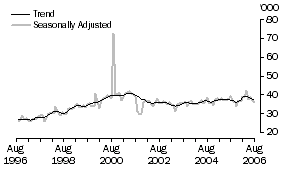
New Zealand
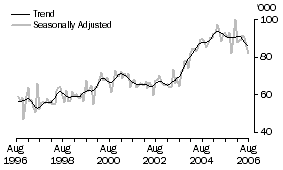
Japan
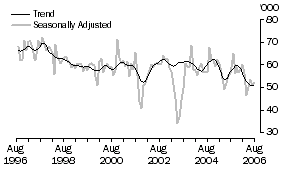
SHORT-TERM RESIDENT DEPARTURES
Selected destinations
For residents departing to the United States of America the graph illustrates the effect of the 11 September 2001 terrorist attacks in that country on short-term departures of Australian residents to the United States of America. The graph for New Zealand indicates that the trend series for departures of Australian residents may again be increasing after a period of steady movements since mid-2004. For Indonesia the graph shows the impact of the 12 October 2002 Bali bombing and the reduced level of travel experienced in the next twelve months. The effect of the 1 October 2005 Bali bombing is also evident and another break in the trend series was introduced.
United States of America
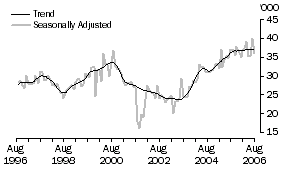
New Zealand

Indonesia
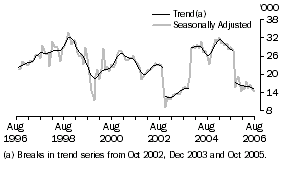
 Print Page
Print Page
 Print All
Print All